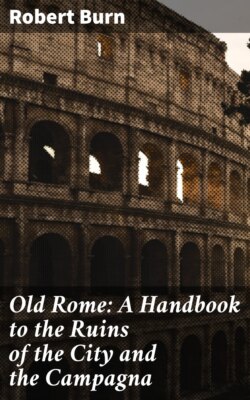Читать книгу Old Rome: A Handbook to the Ruins of the City and the Campagna - Burn Robert - Страница 5
На сайте Литреса книга снята с продажи.
CHAPTER I.
ОглавлениеTable of Contents
THE PALATINE AND VELIA.
The entrance to the ruins on the Palatine Hill is now made through a gateway opposite to the Basilica of Constantine. This gateway was erected by the architect Vignola in the sixteenth century as an approach to the Farnese Gardens, which formerly occupied the north-western part of the Palatine Hill. On the right and left hand of the gateway are placed two ancient pedestals, which were discovered near the Arch of Septimius Severus in 1547. One of these, which stands on the right hand, supported an equestrian statue of Constantius, erected by Neratius Cerealis, prefect of the city in A.D. 353, in commemoration of the expulsion from Italy and death of Maxentius.[1] On the left side pedestal, a representation of the Suovetaurilia is sculptured in bas-relief, and the decennalia vota, or ten years’ good wishes to Constantius and Galerius are mentioned. The side of the hill at the back of the gateway of Vignola is terraced at several levels, on the third of which ascending from the entrance, a part of the pavement of an old road, probably the Clivus Victoriæ, leads to the right. The line of this clivus is represented in the marble plan now on the staircase of the Capitoline Museum which plan was made in the time of Septimius Severus.
INDEX TO THE PLAN OF THE PALATINE RUINS.
| 1, 2. Entrance. 3. Clivus Victoriæ. 4. Museum. 5. Water reservoir. 6. Fragments of ruins. 7. Altar of Calvinus. 8. Fragments of ruin. 9. Domus Gelotiana. 10. Figure of crucified ass. 11. Stadium Palatinum. 12. Exedra. 13. Baths. 14. Palatine Belvedere. 15. Imperial Box over Circus. 16. Augustan Palace. 17. Ruin called the Academy. 18. Triclinium. 19. Viridarium. 20. Peristylium. 21. Smaller chambers. 22. Basilica. | 23. Imperial reception hall. 24. Lararium. 25. Area Palatina. 26. Fragment of ancient ruin. 27. Clivus Palatinus. 28. Porta Mugionia. 29. Temple of Jupiter Stator. 30. Walls of substruction. 31. Cryptoporticus. 32. Subterranean passage. 33. Piscina. 34. House of Tiberius. 35. Well. 36. Unknown ruins. 37. So-called Temple of Jupiter Victor. 38. Uncertain basements. Scala Caci. 39. So-called Auguratorium. 40. Soldiers’ quarters. 41. Garden. 42, 43. Staircase and substructions of Caligula’s buildings. 44. Ruins of lavacrum of Heliogabalus. | |
| ——> Path to be followed. |
To face Plan on p. 14.
